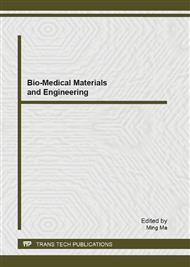[1]
Goole J., Amighi K.: Levodopa delivery systems for the treatment of Parkinson's Disease: an overview, International Journal of Pharmaceutics, Vol. 380, issues 1-2, pp.1-15 (2009).
DOI: 10.1016/j.ijpharm.2009.07.026
Google Scholar
[2]
Lindgren H., Cenci M., Lane E.: Dyskinesia-Advances in understanding of pathophysiology and possible treatment options, European Neurological Review, 5(2): 34-40 (2010).
Google Scholar
[3]
Pillay S.: Design and development of an implantable drug delivery polymeric scaffold for the treatment of Parkinson's disease, Master's dissertation, Faculty of Health Sciences, University of Witwatersrand, Johannesburg (2009).
Google Scholar
[4]
Kulkarni P., Keshavayya J.: Chitosan-sodium alginate biodegradable interpenetrating polymer network (IPN) beads for delivery of ofloxacin hydrochloride, International Journal of Pharmacy and Pharmaceutical Sciences, 2 (2), pp.77-82 (2010).
Google Scholar
[5]
Filipovid-G, J., Maysinger D., Jalgenjak I.: Macromolecular prodrugs. IV. Alginate-chitosan microspheres of PHEA-L-dopa adduct, International Journal of Pharmaceutics, Vol. 116, pp.39-44 (1995).
DOI: 10.1016/0378-5173(94)00269-b
Google Scholar
[6]
Kulkarni R., Yogesh &, Wagh J.: Crosslinked alginate films as rate controlling membranes for transdermal drug delivery applications, Journal of Macromolecular Science, Part A (2010).
DOI: 10.1080/10601325.2010.483620
Google Scholar
[7]
Biscaia S.: Produção e caracterização de matrizes de alginato da alga Laminaria hyperborea para aplicação em engenharia de tecidos, Master's thesis, Escola Superior de Tecnologia e Gestão, Instituto Politécnico de Leiria (2011).
DOI: 10.21011/apn.2022.3010
Google Scholar
[8]
Viana T.: Produção de estruturas de alginato Macrocystis pyrifera e alginato-quitosano, Master's thesis, Escola Superior de Tecnologia e Gestão, Instituto Politécnico de Leiria (2011).
DOI: 10.20872/24478407/regmpe.v5n1p102-131
Google Scholar
[9]
Fwo-Long-Mi Fwu-Long Mi, Hsiang-Fa Liang, Yung-Chih Wu, Yu-Shin Lin, Ting-Fan Yang, Hsing-Wen Sunget: pH-sensitive behavior of two-component hydrogels composed of N, O-carboxymethyl chitosan and alginate, Journal Biomaterials, Science Polymer Edn, Vol. 16, nº 11, pp.1333-1345 (2005).
DOI: 10.1163/156856205774472317
Google Scholar
[10]
Saeedi M., Akbari J., Enayatifard R., Morteza-Semnani K., Tahernia M. and Valizadeh H.: In Situ Cross-Linking of Polyanionic Polymers to Sustain the Drug Release from Theophylline Tablets, Iranian Journal of Pharmaceutical Research. Vol. 8, issue 4, pp.241-249 (2009).
Google Scholar
[11]
Nokhodchi A., Tailor A.: In situ cross-linking of sodium alginate with calcium and aluminum ions to sustain the release of theophylline from polymeric matrices, Farmaco. Vol. 59, issue 12, pp.999-1004 (2004).
DOI: 10.1016/j.farmac.2004.08.006
Google Scholar
[12]
Moffat A., Osselton M., Widdop B.: Clarke's Analysis of Drugs and Poisons. Medicines Complete, The Pharmaceutical Press (2012).
Google Scholar
[13]
Kadajji V.G., Betageri G. V., Venkatesan N.: Approaches for Dissolution Testing of Novel Drug Delivery Systems, American Pharmaceutical Review. Vol. 14, issue 6 (2011).
Google Scholar
[14]
Sarmento B., Ferreira D., Veiga F., Ribeiro A.: Characterization of insulin-loaded alginate nanoparticles produced by ionotropic pre-gelation through DSC and FTIR studies, Carbohydrate Polymers, Vol. 66, p.1–7 (2006).
DOI: 10.1016/j.carbpol.2006.02.008
Google Scholar
[15]
Gazori T., Khoshayand M., Azizi E., Yazdizade P., Nomani A., Haririan I.: Evaluation of Alginate/Chitosan nanoparticles as antisense delivery vector: Formulation, optimization and in vitro characterization, Carbohydrate Polymers, Vol. 77, p.599–606 (2009).
DOI: 10.1016/j.carbpol.2009.02.019
Google Scholar
[16]
Mulla N.: Novel sustained release formulation of levodopa-dendrimer conjugate, Master's thesis, Creighton University, Omaha (2009).
Google Scholar
[17]
US Pharmacopeia 29. NF 24, p.3050.
Google Scholar


